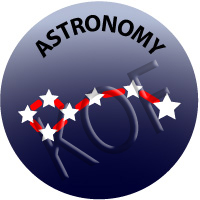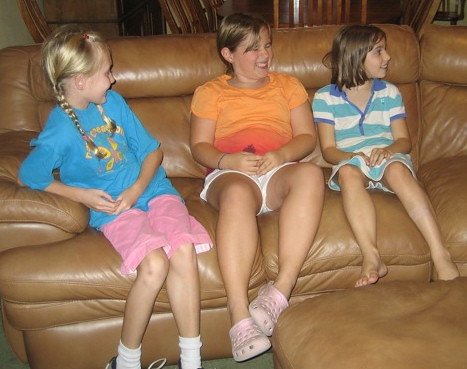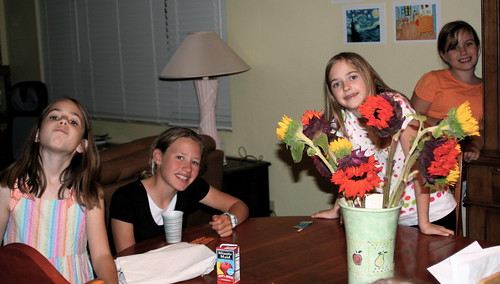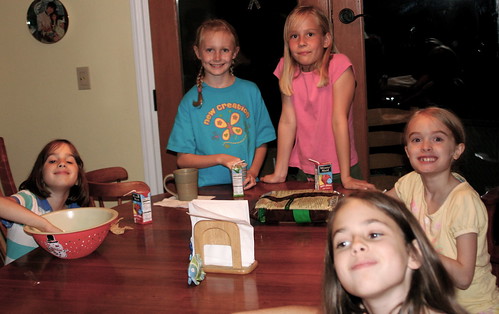It was great seeing everyone again after the summer break. We welcomed our new members, Tessa and her mom Diane. We are so happy to have you both in our group. Rachel and Suzanne, we missed you both! Hope to see you next month.

"Is not God in the height of heaven? and behold the height of the stars, how high they are!" Job 22:12
"Canst thou bind the sweet influences of Pleiades, or loose the bands of Orion?"
"Knowest thou the ordinances of Heaven?" Job 38:31-33
"Knowest thou the ordinances of Heaven?" Job 38:31-33
After reciting our purpose, verse and goal we sang our hymn for this month, How Great Thou Art. You all did a great job singing along w/ the CD, even though the singer was a little low for everyone! LOL Keep listening to the CD you took home so next month we can try to sing the song w/o the CD. 

The Center of the Trifed Nebula An area of star formation
An area of star formation
We learned how to read a starmap, talked about the North Star or Polaris, named the planets as we looked at great images from NASA then we went outside! We took our red filtered lights, so we didn’t lose our night vision w/ bright white lights, and our starmaps and headed into the darkened backyard.
Fortunately, the moon hadn’t risen yet, so we had a pretty good sky for this area. There were some clouds around the horizon as well as a lot of light pollution, but a good portion of the sky was unobstructed.
We first found The Big Dipper as it’s handle arched over the Carob tree. From the Big Dipper we used the pointer stars to find the Little Dipper. Unfortunately, the only part of the Little Dipper that we could really see well was Polaris. Which is a good star to find and one of the requirements for the badge! From the Little Dipper we followed the northern sky to the east until the large W was seen. The W was on it’s side and resemebled a 3 more than a W, but we all knew that was the great, beautiful Queen, Cassiopeia, another requirement for our badge. Perseus was lost in the light pollution but we did find Pegasus, the great winged horse looking suspiciously like a baseball diamond.  Hanging onto Pegasus we saw some of Andromeda, the beautiful princess who was just saved from the horrible sea monster by her hero, Perseus. Down along one of the lines that make up Andromeda you’ll find M31, which is Messier object 31 or the 31st deep sky object that was classified. M31 is also known as the Andromeda Galaxy. The Andromeda Galaxy is the closest galaxy to us and is a spiraling galaxy, like our own Milky Way. I couldn’t find a public domain picture but here’s a link to a picture you can check out.
Hanging onto Pegasus we saw some of Andromeda, the beautiful princess who was just saved from the horrible sea monster by her hero, Perseus. Down along one of the lines that make up Andromeda you’ll find M31, which is Messier object 31 or the 31st deep sky object that was classified. M31 is also known as the Andromeda Galaxy. The Andromeda Galaxy is the closest galaxy to us and is a spiraling galaxy, like our own Milky Way. I couldn’t find a public domain picture but here’s a link to a picture you can check out.
We also looked at the Zenith, or the very center of the sky. We saw The Summer Triangle, made up of the 1st magnitude stars, Vega, Deneb and Altair. In The Summer Triangle we picked out the constellation, Cygnus, the beautiful swan w/ his wings outstretched. A couple others also found Delphinus and Lyra.
We then looked over to the Southern sky. Low on the horizon we found the Teapot, also known as Sagittarius. I mentioned the Trifid Nebula, which is an area of star formation. The Trifid Nebula is located just above the spout of the teapot, right where the steam would be if it were set on the stovetop. Away from light pollution you can see the the Trifid Nebula with just your eyes, it would look like a wispy cloud (or steam). Here are some NASA images (aren’t they cool):

The Center of the Trifed Nebula
 An area of star formation
An area of star formationRight next to Sagittarius (to the west) is Scorpius, the gigantic scorpion residing in the southern summer sky! I pointed out Antares, a reddish first magnitude star, which is said to be the heart of the scorpion.




Some of us went to the Stargazing Party put on by the Phoenix Astronomical Society the next evening. They had their telescopes set up to view the moons of Jupiter. There was also a man with his collection of meteorites. Very cool. For those who went to the Star Party, leave a comment and share what you learned and what you liked best! (those who didn’t go to the party, leave a comment and let us know what constellations you’ve been looking at and which one is your favorite). The astronomical society has star parties every second Thursday of the month. They are free to the public and are a great family outing. Just a reminder, they are scientists and you will be hearing things that may not jive with your views of how life, the earth, the universe, etc. came into existence. We used our experience as a great discussion on our drive home.
In the western sky a bright star was pointed out. That star is the first magnitude star, Arcturus, which is located in the constellation, Bootes. An easy way to find and remember several constellations in this area is to find the big dipper handle. Follow the handle from the bowl to the tip of the handle and "arc to Arcturus", now you’re in Bootes, the protector of the Great Bear (The Big Dipper is just a small portion of the constellation Ursa Major). Draw a line from Arcturus towards the zenith and you’ll see another bright star. Not quite as bright as Arcturus but brighter than the majority of stars in that area. That star is located in the constellation Corona Borealis, or The Northern Crown. This constellation looks like a smiley face, or a skate board ramp. If you use Corona Borealis as a skateboard ramp towards the zenith (away from Arcturus), you’ll jump right into the middle of Hercules! Hercules looks like a lot like an open book or a butterfly. There are several deep sky objects in Hercules. M13 is known as the Hercules Cluster. It’s a globular cluster of stars. You can check out a picture and some info here.
Have the girls go outside and find the constellations as much as possible. The more they look for them the easier they will find them. Have them share what they have found with other members of your family!
We almost completed the badge. There are just a couple of things left for the girls to do on their own. The Moon Phase worksheet I handed out is not a requirement. That was just something for them to do if they wanted to.
Requirements for the Astronomy Badge:
- Read a book about Astronomy
- Name the planets – finished
- Name the planets from smallest to largest
- Find and identify the constellation The Big Dipper – finished
- Find and identify the constellation The Little Dipper – finished
- Find and identify the North Star – finished
- Find Cassiopeia – finished
- Find another constellation that may only be up at a certain time of the year – we found a bunch and will continue to throughout the year.
- Demonstrate how to tell directions from the sky – face the north star. Using Polaris as the top of your circle, go clockwise around and don’t forget to Never Eat Slimy Worms!
- Try to find either Jupiter, Venus or Mars (find all if you’re able but only one is required) – finished, we found Jupiter.
Pictures, pictures, everybody loves pictures!





Some of us went to the Stargazing Party put on by the Phoenix Astronomical Society the next evening. They had their telescopes set up to view the moons of Jupiter. There was also a man with his collection of meteorites. Very cool. For those who went to the Star Party, leave a comment and share what you learned and what you liked best! (those who didn’t go to the party, leave a comment and let us know what constellations you’ve been looking at and which one is your favorite). The astronomical society has star parties every second Thursday of the month. They are free to the public and are a great family outing. Just a reminder, they are scientists and you will be hearing things that may not jive with your views of how life, the earth, the universe, etc. came into existence. We used our experience as a great discussion on our drive home.
Our next unofficial meeting will be on September 21st from 2-4ish. Come hang out and play at our house.
See you next month, at my home, where Diane will be teaching Croquet!


No comments:
Post a Comment